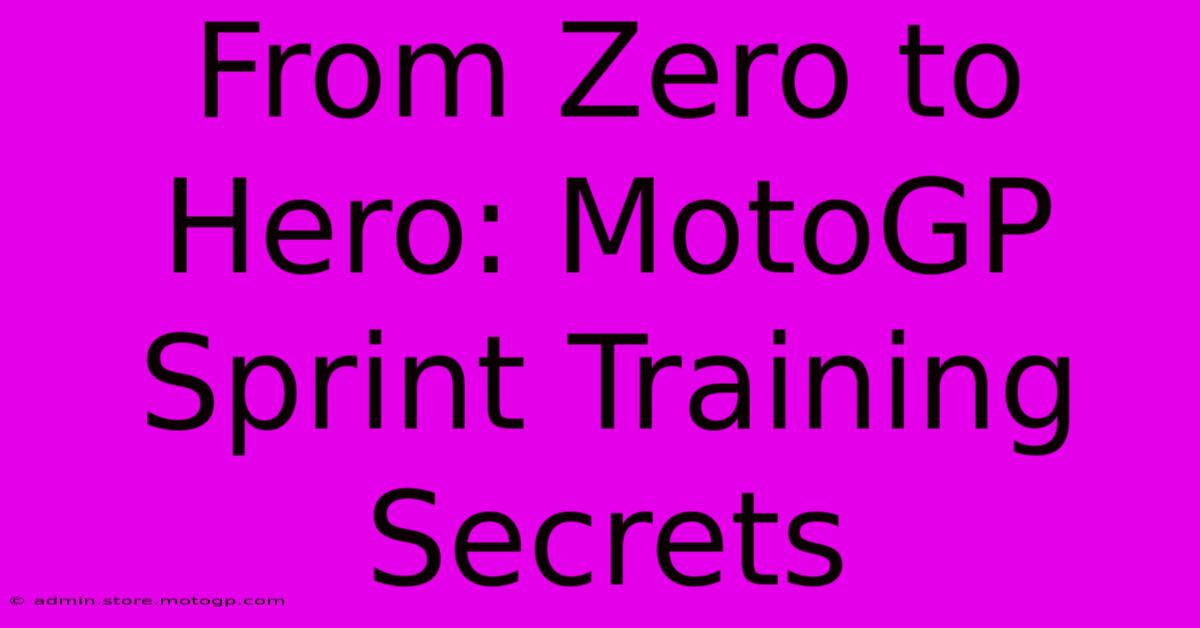From Zero To Hero: MotoGP Sprint Training Secrets

Table of Contents
From Zero to Hero: MotoGP Sprint Training Secrets
The roar of the crowd, the smell of burning rubber, the adrenaline rush of speeds exceeding 200mph – MotoGP is the pinnacle of motorcycle racing. But behind the glory and the breathtaking overtakes lies a relentless pursuit of perfection, demanding grueling training regimes. This article delves into the intense preparation required for MotoGP's new sprint races, revealing the secrets that transform aspiring riders into champions. We'll explore the physical, mental, and technical components vital for success in these high-stakes, short-burst events.
The Physical Demands: More Than Just Muscle
MotoGP sprint races are incredibly demanding, requiring explosive power, incredible stamina, and exceptional reaction times. Forget the image of just raw strength; it's about precision and endurance. The riders aren't simply battling opponents; they're fighting against the physical toll of intense acceleration, braking, and lean angles sustained over a shorter, but equally intense, period.
Key Physical Training Components:
- High-Intensity Interval Training (HIIT): This is a cornerstone of MotoGP training. HIIT mimics the stop-and-go nature of the race, building both anaerobic and aerobic capacity. Expect short bursts of intense cycling, running, or even specialized motorcycle simulators, followed by brief recovery periods.
- Strength and Conditioning: Focus shifts from sheer bulk to functional strength. Core strength is paramount for stability and control during high-speed maneuvers. Leg strength is crucial for managing the bike's weight and inputting power during acceleration. Upper body strength aids in maintaining control during braking and cornering.
- Flexibility and Mobility: Maintaining flexibility and a wide range of motion is essential to minimize injury risk and maximize performance. Yoga, Pilates, and regular stretching are crucial for preventing muscle strains and improving reaction time.
- Nutrition and Hydration: Fueling the body correctly is as important as the training itself. MotoGP riders follow strict dietary plans, focusing on nutrient-rich foods that provide sustained energy and aid recovery. Hydration is critical to prevent dehydration and maintain optimal performance throughout the race.
Mental Fortitude: The Unsung Hero
The mental game in MotoGP is just as crucial as the physical. Sprint races demand intense focus and the ability to make split-second decisions under immense pressure. A single mistake can cost precious time and potentially the race.
Honing Mental Strength:
- Visualization: Riders regularly visualize themselves navigating the track, executing perfect lines, and overtaking opponents. This mental rehearsal strengthens neural pathways and builds confidence.
- Stress Management Techniques: Mindfulness, meditation, and breathing exercises help riders manage the pressure and stay calm under intense situations.
- Data Analysis: Analyzing race data, studying opponents' riding styles, and identifying areas for improvement is critical for strategic decision-making.
- Mental Coaching: Many top riders work with sports psychologists to hone their mental skills, improve focus, and develop strategies for managing pressure and setbacks.
Technical Mastery: The Art of the Machine
Sprint races emphasize clean, efficient riding. Every second counts, so mastering the technical aspects of the bike is paramount.
Technical Training:
- Bike Setup: Fine-tuning the motorcycle's suspension, ergonomics, and electronic controls is crucial for optimizing performance. Even small adjustments can significantly impact lap times.
- Riding Technique: Refinement of braking, cornering, and acceleration techniques is ongoing. MotoGP riders continuously work on optimizing their body position and bike control.
- Data Acquisition: Advanced telemetry systems provide detailed data on various aspects of the ride, allowing for meticulous analysis and improvement.
- Race Simulation: Utilizing simulators helps riders practice race strategies, refine their technique, and adapt to different track conditions.
Conclusion: The Sprint Race Formula
Success in MotoGP sprint races demands a holistic approach that seamlessly integrates physical training, mental fortitude, and technical mastery. It's a relentless pursuit of perfection, demanding unwavering commitment and dedication. The secrets to becoming a MotoGP sprint race hero aren't just about raw talent; they're about meticulous preparation, a relentless work ethic, and the unwavering pursuit of excellence in every aspect of the rider's performance. From zero to hero, the journey is grueling, but the reward is unparalleled.

Thank you for visiting our website wich cover about From Zero To Hero: MotoGP Sprint Training Secrets. We hope the information provided has been useful to you. Feel free to contact us if you have any questions or need further assistance. See you next time and dont miss to bookmark.
Featured Posts
-
Your Personal F1 Chauffeur Austin Shuttle Service
Feb 19, 2025
-
Racing Motorcycles Where Passion Meets Performance
Feb 19, 2025
-
The Power Of Dreams Moto Gp Horsepower Revealed
Feb 19, 2025
-
Moto Gp Photoshoot The Poetry Of Motion
Feb 19, 2025
-
Columbus Adventures Made Affordable Cota One Day Pass
Feb 19, 2025
